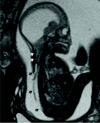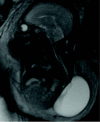Fetal US and MRI in detection of craniospinal anomalies with postnatal correlation: single-center experience
- PMID: 33517612
- PMCID: PMC8283491
- DOI: 10.3906/sag-2011-122
Fetal US and MRI in detection of craniospinal anomalies with postnatal correlation: single-center experience
Abstract
Background/aim: To reveal the contribution of magnetic resonance imaging (MRI) to ultrasound (US) in prenatal diagnosis of fetal craniospinal anomalies by retrospectively comparing the prenatal and postnatal findings.
Materials and methods: After institutional review board approval, between January 2010 and May 2020, 301 pregnant women, which had a gestational age between 19–37 weeks (mean 26.5 ± 6.1 weeks), diagnosed with cranial and spinal anomalies on fetal US and later on imaged with MRI were evaluated, and in 179 of those cases prenatal imaging findings were compared with postnatal findings.
Results: A total of 191 fetal craniospinal anomalies were detected in 179 pregnant women. MRI and US diagnosis were completely correct in 145 (75.9%) and 112 (58.6%), respectively. Diagnostic performance of MRI was significantly higher than that of the US (p < 0.05). Both prenatal MRI and US findings were concordant with postnatal diagnosis in 53% of the cases. In 28.7% cases, prenatal MRI contributed to US by either changing the wrong US diagnosis (8.9%), demonstration of additional findings (14%), or confirming the suspicious US diagnosis (5.8%).
Conclusion: Due to its high resolution and multiplanar imaging capability, fetal MRI contributes significantly to US in the correct prenatal diagnosis of craniospinal anomalies. This contribution especially is significant in neural tube defects, cortical malformations, and ischemic-hemorrhagic lesions.
Keywords: Fetal MRI; craniospinal malformations; fetal ultrasound; prenatal diagnosis.
This work is licensed under a Creative Commons Attribution 4.0 International License.
Conflict of interest statement
none declared.
Figures




Similar articles
-
Role of magnetic resonance imaging in fetuses with mild or moderate ventriculomegaly in the era of fetal neurosonography: systematic review and meta-analysis.Ultrasound Obstet Gynecol. 2019 Aug;54(2):164-171. doi: 10.1002/uog.20197. Epub 2019 Jul 11. Ultrasound Obstet Gynecol. 2019. PMID: 30549340
-
Fetal Neurosonogaphy: Ultrasound and Magnetic Resonance Imaging in Competition.Ultraschall Med. 2016 Dec;37(6):555-557. doi: 10.1055/s-0042-117142. Epub 2016 Dec 15. Ultraschall Med. 2016. PMID: 27978593 English.
-
Contribution of Magnetic Resonance Imaging to Ultrasound for the Evaluation of Fetal Central Nervous System Anomalies.J Reprod Med. 2017 May-Jun;62(5-6):295-9. J Reprod Med. 2017. PMID: 30027723
-
Role of prenatal magnetic resonance imaging in fetuses with isolated severe ventriculomegaly at neurosonography: A multicenter study.Eur J Obstet Gynecol Reprod Biol. 2021 Dec;267:105-110. doi: 10.1016/j.ejogrb.2021.10.014. Epub 2021 Oct 23. Eur J Obstet Gynecol Reprod Biol. 2021. PMID: 34773875
-
Fetal MRI assessment of posterior fossa anomalies: A review.J Neuroimaging. 2021 Jul;31(4):620-640. doi: 10.1111/jon.12871. Epub 2021 May 8. J Neuroimaging. 2021. PMID: 33964092 Review.
Cited by
-
A single-center experience of magnetic resonance imaging findings of fetal sacrococcygeal teratomas.Turk J Med Sci. 2022 Aug;52(4):1190-1196. doi: 10.55730/1300-0144.5423. Epub 2022 Aug 10. Turk J Med Sci. 2022. PMID: 36326365 Free PMC article.
-
Frontonasal Dysplasia: A Diagnostic Challenge with Fetal MRI in Twin Pregnancy.Child Neurol Open. 2023 Mar 6;10:2329048X231157147. doi: 10.1177/2329048X231157147. eCollection 2023 Jan-Dec. Child Neurol Open. 2023. PMID: 36910596 Free PMC article.
-
Use of magnetic resonance imaging in the diagnosis of fetal vertebral abnormalities in utero: a single-center retrospective cohort study.Quant Imaging Med Surg. 2022 Jun;12(6):3391-3405. doi: 10.21037/qims-21-1070. Quant Imaging Med Surg. 2022. PMID: 35655821 Free PMC article.
References
-
- Goldberg JD Routine screening for fetal anomalies: expectations. Obstetrics and Gynecology Clinics of North America . 2004;31:35–50. - PubMed
-
- Kul S Korkmaz HA Cansu A Dinc H Ahmetoglu A Contribution of MRI to ultrasound in the diagnosis of fetal anomalies. Journal of Magnetic Resonance Imaging . 2012;35:882–890. - PubMed
-
- Salomon LJ Alfirevic Z Berghella V Bilardo C Hernandez-Andrade C ISUOG Clinical Standards Committee. Practice guidelines for performance of the routine mid-trimester fetal ultrasound scan. The Ultrasound in Obstetrics and Gynecology . 2011;37:116–126. - PubMed
-
- Manganaro L Bernardo S Antonelli A Vinci V Saldari M Fetal MRI of the central nervous system: state-of-the-art. European Journal of Radiology . 2017;93:273–283. - PubMed
-
- Blaicher W Prayer D Bernaschek G Magnetic resonance imaging and ultrasound in the assessment of the fetal central nervous system. Journal of Perinatal Medicine . 2003;31:459–468. - PubMed
MeSH terms
LinkOut - more resources
Full Text Sources
Other Literature Sources
Medical

